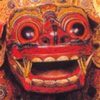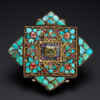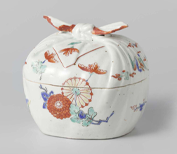LOUIS NG
Director of Hong Kong Palace Museum

LOCATED AT THE western tip of the West Kowloon Cultural District (WestK) in Hong Kong, the Hong Kong Palace Museum (HKPM) opened in July 2022 after five years in the making (1). Over 900 spectacular works, displayed at seven opening exhibitions, were gems on loan from the Palace Museum collection in Beijing (2). Since its opening, the museum has taken new curatorial approaches to present twenty-one thematic and special exhibitions, featuring its own growing collection and new works by Hong Kong artists, as well as priceless loans from the Palace Museum and significant collections around the globe.

The HKPM has welcomed nearly 2.8 million visitors from home and abroad. Through a dynamic mix of learning programmes, we have offered a wide range of resources for local and global visitors to study and appreciate Chinese and world art and culture (3). Today, the museum is home to a growing collection of diverse works, ranging from metalwork to ceramics, furniture, textiles, and modern and contemporary paintings, all acquired through donation (4). Thanks to the hard work of our staff and the incredible support of our visitors, donors, friends, patrons, partners, sponsors and many other stakeholders, the museum has become a must-see cultural landmark and an indispensable platform for learning, community engagement, collaboration and creativity in Hong Kong.

With the mission of advancing dialogue among world civilisations and building international partnerships, the museum utilises cross-cultural approaches to curation and interpretation for local and global audiences.
With a Hong Kong perspective and a global vision, the museum embraces new curatorial approaches to present the finest objects from the Palace Museum and other important cultural institutions around the world. Cosmopolitanism is a defining feature of Qing (1644–1911) court culture. While the Forbidden City in Beijing is a repository of more than 1.8 million treasures of Chinese art, a significant portion of its collection came from Japan, Korea, India, Europe and other parts of the world. We present the art, culture and history of the Forbidden City in a global context. The exhibition titled “Entering the Forbidden City: Architecture, Collection, and Heritage” in Gallery 1 displays a number of spectacular works documenting China’s vibrant contacts with the world (5).


Another example of our cross-cultural approach was the special exhibition titled “Grand Gallop: Art and Culture of the Horse”, on view in 2022. It brought together over 100 artworks from the Palace Museum related to horses in China. These works were juxtaposed with thirteen works on loan from the Louvre, featuring horses from France and other countries (6). These meaningful dialogues highlighted the importance of the horse around the globe and celebrated Hong Kong’s position as a centre of art and cultural exchange between China and the rest of the world.
The special exhibition, “Odysseys of Art: Masterpieces Collected by the Princes of Liechtenstein”, on view in 2022 and 2023, featured not only important works by Old Masters, such as Peter Paul Rubens (1577–1640), but also Chinese and Japanese porcelains collected by the princes of Liechtenstein, illustrating how Chinese art influenced cultural life in Europe (7). This exhibition was organised around the theme of how the collection was formed by the princes during a span of four centuries, opening up many points of comparison between European and Chinese rulers as art collectors. In 2023, the HKPM team curated “Cartier and Women”, the first major exhibition on the role and influence of women in Cartier’s history. This exhibition told the story of how Chinese art has inspired European jewellery-making and how Chinese aesthetics have influenced women’s lifestyles and global fashion (8).



The museum creates lively dialogues between the past and the present.
The museum is privileged to present many spectacular treasures from the Palace Museum and other major cultural organisations. How do we make these treasures, created in the distant past, relevant to our lives today? Through storytelling and engaging with new technologies, the museum connects these historical objects to lived experiences and encourages visitors to explore, contemplate and create meaningful experiences. The museum has collaborated closely with artists, designers, technology experts and other creative practitioners to open up new ways of experiencing art and culture.

The exhibition, “The Quest for Originality: Contemporary Design and Traditional Craft in Dialogue”, in Gallery 5 connects the past and the present through the concept of design. With Stanley Wong, the renowned designer, as its artistic director, the show demonstrates the deep interest in innovation, materiality, and function in design shared by people of the past and today (9).
Since its opening, the museum has commissioned and presented more than 100 multimedia and digital projects for its exhibitions. Hong Kong-based leading artists and designers, such as Chiu Kwong-chiu and Jeffrey Shaw, have been invited to create projects that activate, contextualise and interpret the art objects on display while providing visitors with optimal learning opportunities and multisensory experiences (10, 11).


In Gallery 7, a space dedicated to the display of newly commissioned contemporary works, we are collaborating with creative talents to experiment with new ways of presenting Chinese art and culture and connecting traditions to the vibrant art scene in Hong Kong today. In 2023, eight Hong Kong artists created new works for the exhibition titled “The Hong Kong Jockey Club Series: Dwelling in Tranquillity — Reinventing Traditional Gardens” (12). Through kinetic, multimedia and sound installations, inspired by their field trips to the Forbidden City and many historical gardens, the artists shed new light on the time honoured Chinese garden philosophy and design, as well as Hong Kong’s local garden culture.

Supported by our visitors, donors, friends, partners, patrons, sponsors and many other stakeholders, the museum is at heart a resource that belongs to our community. It inspires engagement, fosters dialogue, and promotes creativity and interdisciplinary collaboration.
Today, the museum is home to more than 1600 works of art generously donated by art collectors and artists. The special exhibition, “Radiance: Ancient Gold from the Hong Kong Palace Museum Collection and the Mengdiexuan Collection”, presented over 200 works assembled by the distinguished art collectors, Ms Betty Lo Yan-yan and Mr Kenneth Chu Wai-kee (13). On view in 2023, this exhibition highlighted the artistic and technical achievements of goldsmithing in ancient China and the dynamic connections across Asia over the past 3000 years (14). A selection of newly acquired works is on display in Gallery 6 in “Passion for Collecting: Founding Donations to the Hong Kong Palace Museum”, an exhibition that celebrates the museum’s foundational collection built through the generosity of fourteen donating parties. We plan to launch and take on tour a series of exhibitions and learning programmes in 2025 and there after, featuring our new acquisitions and promised major gifts, with the goal of broadening the access and impact of our collection. A few other initiatives, such as collection conservation projects, are organised to provide our collection with the state-of-the-art facilities and best care.


Our learning and engagement programme has three key areas: the Palace Academy, School and Youth and Community Engagement. The Palace Academy, with its Learning Resource Centre, is the largest dedicated museum learning space in Hong Kong. Its rich offerings drew over 500,000 participants onsite and online between July 2022 and August 2024. The HKPM Talk Series offers free public talks by leading experts in and outside of the museum, providing fresh insights into our exhibitions and collection, as well as world cultures. Other offerings include art-making and conservation workshops, movie screenings and performing arts series featuring Hong Kong’s top performing art talents and troupes.
The museum’s School and Youth Programme combines museum visits with object-based learning, hands-on workshops and school outreach initiatives to help students immerse themselves in Chinese art and culture. Since the museum opened, we have welcomed more than 120,000 students and teachers who visited the museum in groups from some 700 schools across Hong Kong (15). We have partnered with the Hong Kong Education Bureau and school teachers to create teachers’ resource books, which combine museum exhibition content with the school curriculum. The museum’s Student Ambassador Programme and Bi-city Youth Cultural Leadership Programme have provided training opportunities and leadership skills to hundreds of secondary school and university students to prepare them as future leaders in the fields of art and culture. The museum’s Community Engagement Programme has recruited and trained over 700 volunteers and docents and offered free tickets and special programmes to underprivileged communities and people with special needs.


The museum plays an important role in helping position Hong Kong as a global hub for art and culture, and a bridge connecting China and the world.
I have often been asked: How does the Hong Kong Palace Museum differentiate itself from its counterparts in Beijing and Taipei in terms of vision and positioning? Here, I would like to share with you the work we have been doing to build robust local, domestic and international partnerships. The HKPM is strengthening its ties with mainland and international museums and audiences, contributing to the overall strategy of developing Hong Kong as an East meets-West centre for art and cultural exchange. We have established professional contacts with many major museums around the world with the goal of establishing a robust network of partners in the fields of travelling exhibitions, research, education, conservation, professional development, and more. In the effort to build a strong global cultural network, the West Kowloon Cultural District Authority hosted the Hong Kong International Cultural Summit 2024 from March 24th to 26th, 2024, as the largest international cultural conference ever staged in Hong Kong. The HKPM signed MOUs with seven leading arts and cultural institutions from across the globe (16). Our strategic partnerships with the Palace Museum, the Shanghai Museum, the Sanxingdui Museum, and other major museums, have resulted in highly successful exhibitions, including “Gazing at Sanxingdui: New Archaeological Discoveries in Sichuan” and “YUAN MING YUAN: Art and Culture of an Imperial Garden-Palace” (17, 18).


In late 2023, thanks to the generous support of the Bei Shan Tang Foundation, we co-organised with the Palace Museum and the Dunhuang Academy the inaugural International Symposium on Chinese Art Conservation, with the aim of formulating a roadmap for this fast-changing field, both locally and globally, and fostering international and inter-institutional collaboration (19).
In the field of scholarly publication, our strategy is to create the best publications in Chinese art that can be distributed locally, domestically and internationally, with the goal of broadening the reach of Chinese art by working closely with Hong Kong designers, mainland publishers, printing houses and international distributors to leverage local, regional and international resources. The Sanxingdui exhibition catalogue has three editions in Traditional Chinese, Simplified Chinese and English (20).


Looking ahead, the world is undergoing a period of change unprecedented in modern history. As important vehicles of culture, history and values, museums are powerhouses that can contribute to building a community with a shared future for mankind. The idea of a “connected museum” captures the distinct identity and role of the Hong Kong Palace Museum in advocating a new paradigm for the interpretation of Chinese art and culture. In this context, the concept of connection has multiple meanings—to connect the past with the present, increase hyper connectivity, strengthen connections with museums and audiences in Hong Kong and the mainland, and connect Chinese culture with global audiences. The HKPM will stay committed to its vision of positioning and developing Hong Kong as an East-meets-West centre for international cultural exchange.
Please click here to view the contents of this issue.

 Subscribe
Subscribe Calendar
Calendar Links
Links Gift
Gift


